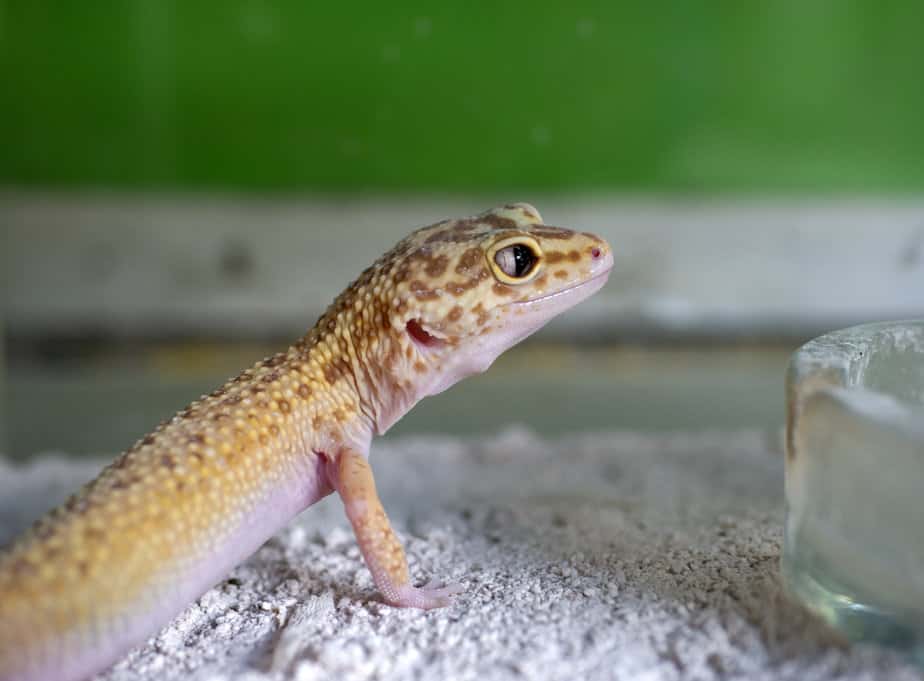Native to arid terrains, leopard geckos have adapted to survive in environments with limited water sources. However, providing your leopard gecko with clean and fresh water is a crucial part of their care, and understanding the impacts of dehydration will help keep your pet healthy and happy.
A leopard gecko can go without water for two to three days. After this time, dehydration can set it. However, its worth providing a water source in your leopard geckos enclosure to ensure it has 24/7 access to fresh water.

Factors Affecting Water Consumption
Age and Size
Younger and smaller leopard geckos have different hydration needs compared to adults. Their smaller size and lower energy reserves make them more susceptible to dehydration. They require more frequent access to water. Make sure to provide water for hatchlings and juveniles accordingly.
Diet and Nutrition
Your leopard gecko’s diet plays a significant role in their hydration levels. Some insects, like crickets and mealworms, contain high amounts of moisture.
If your leopard gecko’s diet mainly consists of such insects, they might get enough water from their food and drink less from a water dish.
It’s best to give your leopard gecko live insects as these have a higher moisture content. Dried insects don’t contain enough moisture and will have to be supplemented with a water source.
Health Conditions
Certain health conditions can impact your leopard gecko’s water consumption. For example, kidney or urinary issues might make them drink more or less than usual. If you notice any changes in their drinking habits or other signs of illness, consult a reptile veterinarian.
Egg Laying
Egg-laying can also affect water consumption for female leopard geckos. Water requirements increase during the egg-laying process. If your leopard gecko is pregnant, provide an additional water source and monitor her drinking habits to support her during this critical time.
Shedding
Lastly, shedding can influence your leopard gecko’s need for hydration. Shedding causes dry skin, so your Leo might require extra water during this period. Keep an eye on your gecko’s shedding schedule and adjust their hydration accordingly.
Signs of Dehydration
Leopard geckos can go without water for some time, but it’s essential to recognize the signs of dehydration to ensure their health and well-being. In this section, you will learn about the common symptoms of dehydration in leopard geckos.
First, pay close attention to your leopard gecko’s skin. Dehydrated geckos may have wrinkled or loose skin that doesn’t quickly return to its normal state when gently pinched. Their eyes might also appear sunken or dull, indicating a lack of moisture.
Another sign of dehydration is shedding trouble. If you notice your gecko struggling with shedding or having incomplete sheds, providing adequate hydration is essential.
Constipation or infrequent defecation may indicate dehydration, as their digestive system’s effectiveness depends on environmental factors such as humidity and heat.
Dry membranes in your leopard gecko’s mouth are another symptom of dehydration. The side membranes should be moist when healthy, but if they appear sticky or produce strings when your gecko opens its mouth, this can indicate dehydration.
To maintain your leopard gecko’s hydration, make sure they have access to clean water and a humid environment. Monitor their behavior and appearance regularly to detect any signs of dehydration early on, enabling you to take swift action and ensure your pet remains healthy and happy.
Providing Water Sources
As a leopard gecko owner, it’s important to provide adequate water sources for your pet. Here are a few ways to ensure they stay hydrated.
Drinking Dishes
Consider providing a shallow drinking dish with fresh water for your leopard gecko to meet their hydration needs. Make sure to change the water daily to keep it clean and bacteria-free.
A small, shallow dish is ideal, as it prevents your gecko from accidentally drowning or getting stuck in a deeper container. Also, ensure the dish is easily accessible for your gecko to find and drink from.
Spraying and Misting
Although leopard geckos are native to arid regions and don’t require high humidity, occasional spraying or misting can be beneficial. It helps maintain proper hydration and promotes shedding.
Lightly mist your gecko’s enclosure once or twice a week, focusing on their hide areas.
Avoid soaking the entire enclosure, as this can lead to high humidity and creates an environment prone to bacterial growth. Remember that spraying and misting should not replace providing drinking water in a dish.
Moist Hide
Providing a moist hide in your leopard gecko’s enclosure can also help with their hydration. A moist hide is a small container with damp moss or a moisture-retaining substrate, which allows your gecko to burrow and soak up moisture.
This is especially important during shedding, as it helps them remove old skin more easily. To create a moist hide, choose a small, enclosed container with a secure lid and cut an entrance hole large enough for your gecko to enter.
Fill it with damp moss or another suitable substrate, and place it in the enclosure. Ensure to monitor and maintain the moisture levels inside the hide, so your gecko can readily benefit from it.
Final Thoughts
A healthy leopard gecko can generally survive without water for about 48 to 72 hours before dehydration sets in.
Factors such as health, humidity, shedding, and egg-laying can affect how long your leopard gecko can go without water.
It’s essential to always provide your pet with fresh water to prevent dehydration, which can be dangerous or even fatal to your gecko. Regularly monitor the water supply, and ensure you are promptly refilling it, especially when you notice it running low.
